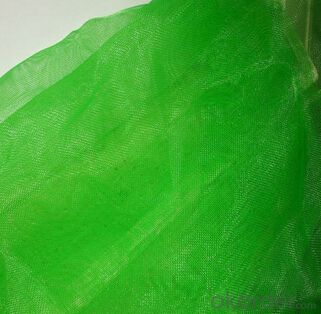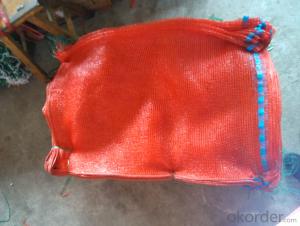Green AntiInsect Net for Agriculture Growing
- Loading Port:
- Ningbo
- Payment Terms:
- TT OR LC
- Min Order Qty:
- 40000 m²
- Supply Capability:
- 10000000 m²/month
OKorder Service Pledge
OKorder Financial Service
You Might Also Like
Anti-Insect Net
Insect net is generally used to protect cultivations from insects. It is the best protection against insects as it avoids the use of insecticides. The anti-insect net can increase vegetable yield and quality, which are green pollution-free foods.

Specifications:
Fabric Weight: 80gsm
Uv. Content: 0.3%
Width: 2.1m/4.2m
Length: 20m, 50m, 100m
Color: Green
Minimum life length: 4 years, under normal weather conditions and use.
Features:
1.It is manufactured of polyethylene mono-filament UV stabilized yarn.
2.It is a very thick mesh net in order to avoid insect (especially aphids) passage.
3.It is plain weaven, light weight, beautiful generous, acid and alkali, ventilated breathe freely, easily clean, qualitative light,cheap, etc.
FAQ:
1. How many years can it be used?
At least three years, it can also be customized according to the customer's requirements.
2. What color is it made?
Black, Green, White, Dark Green, Bule o it is customized according to the customer's requirements.
3. How to transport?
Usually, we use the container by sea transportation.
4. When is the delivery date?
Usually the production needs 30 days, then it will be shipping.
- Q: How are plastic film covers used in agriculture?
- Plastic film covers are used in agriculture to create protective barriers around crops, providing insulation and shelter from harsh weather conditions. These covers help regulate temperature, conserve moisture, and prevent weed growth. Additionally, plastic film covers can also be utilized as mulch to increase soil temperature, retain moisture, and control pests.
- Q: ive had my septum pierced since nov 7th and i want to wear a plastic ring in it, is it healed enough?
- yeahh i changed my monroe after 3 weeks and had no problem youll be fine
- Q: How do you prevent ground cover plants from becoming invasive species?
- One effective way to prevent ground cover plants from becoming invasive species is to carefully select and use native plants that are well-suited to the local environment. This helps maintain a balanced ecosystem by ensuring that the ground cover plants do not outcompete and overrun other native plant species. Additionally, regular monitoring and management practices, such as timely pruning, controlling seed dispersal, and preventing their spread into natural areas, can be implemented to prevent the plants from becoming invasive.
- Q: What are the different types of agricultural plastic sheets?
- There are various types of agricultural plastic sheets available, including greenhouse plastic films, mulch films, silage films, and shade nets.
- Q: Can ground cover be used to create a raised bed cover?
- Yes, ground cover can be used to create a raised bed cover. Ground cover plants, such as low-growing perennial plants or thick mulch, can be used to cover the surface of a raised bed. This helps to retain moisture, suppress weed growth, and protect the soil from erosion. However, it's important to choose ground cover plants that won't compete with the crops in the raised bed for nutrients or water.
- Q: Well obviously the plastics would go after the water cools abit... But anyway. Will it penetrate the plastics? Oh and I said coffee cause I see that some manufacturers use coffee as a scent... In their plastics. Is it actually a good scent? Thanks guys!
- Coffee grounds are IN the plastics... the plastics aren't scented with artificial coffee smell, there are actual coffee grounds in the plastic. Just like people, bass like their caffeine in the morning, so yeah it's a good scent and flavor. Anise scented worms are scented with anise OIL, either in the plastic itself or in the plastic... they aren't boiled with anise seeds. Same with the salt... it's in the plastic... why do you think Senkos are so heavy for a plastic worm? They're loaded with salt! Every company uses a different amount of grains to weigh their worms. Hot water will probably ruin the plastics.
- Q: How are plastic greenhouse films manufactured?
- Plastic greenhouse films are manufactured through a process called extrusion. This involves melting and shaping plastic resin pellets into a continuous sheet using a specialized extruder machine. The molten plastic is then cooled and stretched to achieve the desired thickness and strength. Various additives, such as UV stabilizers and anti-fogging agents, may be incorporated during the manufacturing process to enhance the film's durability and performance in greenhouse environments.
- Q: PE what can the polyethylene granules be made of?
- Coal or oil - producing ethylene - polymerized into polyethylene (i.e., PE); recycled materials are recycled waste materials and spout materials; some PE products.
- Q: i put some gaslione in a plastic cup, then left to get a better container for it, when i returned the plastic cup's bottom fell out and spill gas everwherei didn't know gas can do this...what makes gas eat plastic? how?how come it dosent' eat plastic gas can's (gas containers)
- Gas cans are made of a harder plasticif you put gas on any soft type plastic it will melt ,like a lunch bag or a soft white coffee cup any one of them are going to melt.a milk jug are a coke bottle are one of those type of plastic will work with gas .
- Q: This question asks for methods employed by farmers to prevent soil and water pollution caused by agricultural plastic waste.
- <p>Farmers employ several strategies to prevent contamination of soil and water resources with agricultural plastic waste. They use biodegradable plastics that decompose naturally over time, reducing long-term pollution. Additionally, proper waste management practices such as recycling and proper disposal of non-biodegradable plastics are crucial. Farmers also implement precision agriculture techniques to minimize plastic use and ensure that the plastic used is efficiently targeted. Regular monitoring and maintenance of plastic mulches and other plastic-based agricultural products help in early detection and removal of damaged plastics before they can contaminate the environment. Finally, educating farmers about the environmental impact of plastic waste and promoting sustainable agricultural practices are key in the fight against soil and water contamination.</p>
Send your message to us
Green AntiInsect Net for Agriculture Growing
- Loading Port:
- Ningbo
- Payment Terms:
- TT OR LC
- Min Order Qty:
- 40000 m²
- Supply Capability:
- 10000000 m²/month
OKorder Service Pledge
OKorder Financial Service
Similar products
Hot products
Hot Searches
Related keywords

























